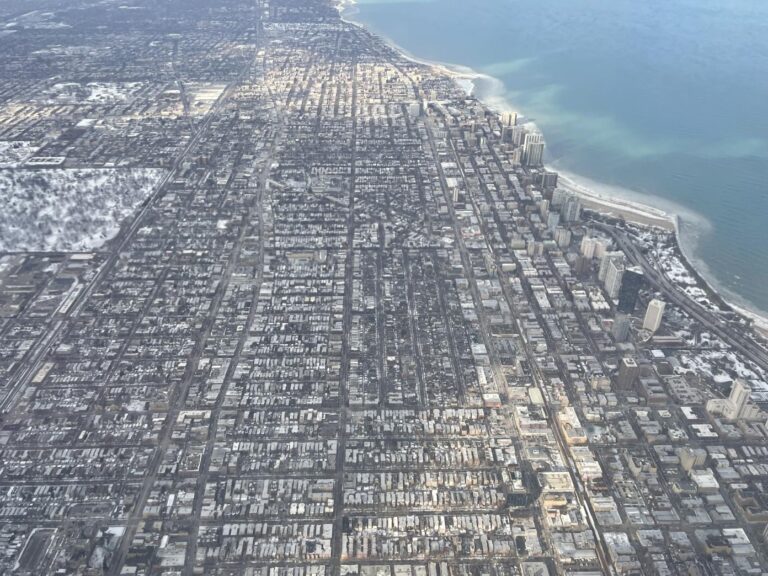
Eli Broad, Transforming Los Angeles through Museums

Ⓒ Carlos Cruz-Diez
By Didier Dutour
Rarely does an individual have as much impact on the cultural landscape of a major city as Eli Broad in Los Angeles. The recent opening of a new cultural center on Wilshire Boulevard, in the heart of Koreatown, is again marked by the businessman and billionaire who died on April 30, 2021, and offers an opportunity to look back at the revitalization of Los Angeles over the past two decades, and its urban transformation through culture.
In 1994, when Eli Broad acquired Roy Lichtenstein’s I…I’m Sorry, he paid for the $2.47 million purchase with his credit card. At the time, his bank ran an offer of one mile for every dollar spent and he gifted the corresponding 2.47 million miles to the students of CalArts for their travels–a handsome donation that he naturally deducted from his taxes! The painting may now be viewed at the Broad Museum in LA.
No other city has been more powerfully affected by this entrepreneur-philanthropist, who left behind an estimated fortune of $7 billion. In 1963, Broad moved from his native Bronx to Los Angeles, where he later founded The Broad contemporary art museum alongside his wife, Edye. Using his wealth built from real estate and insurance, he promoted his passion for contemporary art and helped transform his adoptive home. His actions were instrumental in turning LA into a world-renowned cultural capital. It was through culture that he spearheaded, in particular, the magnificent revival of Downtown, an area that had been severely affected by various crises in the 1990s.
A passion for art by living artists and institutions
In the 1980s, the Broads began building a major contemporary art collection, purchasing works by renowned artists out of their own pocket. Andy Warhol was one such figure, with works selling for exorbitantly high prices. But the couple also acquired artworks by young and emerging artists, such as Chris Burden, Lari Pittman, and Robert Therrien, using the capital from Broad’s home-building firm, Kaufman & Broad.
In 1984, the Broad Art Foundation launched a daring art-lending program that helped increase public access to contemporary art. This allowed 8,700 works from the Broads’ private stores and the Foundation’s own collection to be shown at over 550 museums and galleries across the world.
Eli Broad was also involved in expanding and developing the collections of the city’s various museum institutions. One significant example was in 1984, when he offered the then brand-new Museum of Contemporary Art (MOCA) a collection of 80 works purchased from the great Italian collector Giuseppe Panza di Biumo. These items formed the core of the MOCA’s permanent collection, which gave it “instant credibility” and international recognition, according to The New York Times.
Little by little, the philanthropist quietly exerted his power. Indeed, Broad had a decisive say in choosing who would direct the city’s museums. He brought in his own protégés, placing former UCLA vice-chancellor Andrea Rich at the head of the Los Angeles Contemporary Museum (LACMA) and New York art dealer Jeffrey Deitch at the Museum of Contemporay Art (MOCA), neither of whom had any experience in running a museum. Broad’s role was pivotal again when he appointed Michael Govan from the New York’s DIA Foundation to serve as CEO of the LACMA, in order to open a new wing at the museum with the help of a $50 million donation, but the proposed Broad Contemporary Art Museum (BCAM) never saw the light of day. On the eve of the building’s opening, the collector left the LACMA to set up his own museum, The Broad, which would go on to house 2,000 works by more than 200 artists, including Jean-Michel Basquiat, Jeff Koons, Takashi Murakami, Robert Rauschenberg, Ed Ruscha, Cindy Sherman, Cy Twombly, and Andy Warhol.
It was no coincidence that the building was erected opposite the MOCA and next to Frank Gehry’s Walt Disney Concert Hall, which he had personally funded. With venues sprouting up every which way, Grand Avenue soon became LA’s new cultural epicenter.
A visionary force in reviving Downtown
In the 1970s, Broad had already seen the potential for Grand Avenue, located in the Bunker Hill neighborhood in downtown LA, to become the cultural nexus of Southern California, stating, “A great city needs a vibrant center where people come to enjoy cultural riches like museums, dance, opera, theater, and the symphony, or to take part in civic life at parades, protests, and celebrations.”
But in the mid-1990s, L.A. found itself in crisis. Because of the economic recession, the riots related to the beating of Rodney King, and the Northridge earthquake, residents and companies were leaving the city in droves, while the real estate market plummeted. As a response, Broad launched a number of projects to revitalize the city according to his principles.
In 1996, Broad spearheaded a campaign, alongside Richard Riordan, the former mayor of LA, to raise the $300 million needed to build the Walt Disney Concert Hall on Grand Avenue. Designed by Frank Gehry, the building, which opened in October 2003, is home to the renowned LA Philharmonic and the REDCAT/CalArts gallery and theater.
Shortly afterwards, Broad was involved in the Grand Avenue Project, an initiative led by the city and county of Los Angeles to redevelop sections of Bunker Hill. It resulted in the creation of Grand Park, a new public space located between City Hall and the Music Center. Broad was also a long-standing benefactor of the LA Opera (also on Grand Avenue).
In addition, he contributed to the development of the Ramón C. Cortines School of Visual and Performing Arts. Another Grand Avenue project, it was designed by architect Wolf D. Prix.
It was therefore only natural that he chose this same district for the site of The Broad, the museum he co-founded with Edye, which opened in September 2015.
Eli Broad’s legacy
Broad drew upon contemporary art and the art market as an instrument of urban planning to transform Los Angeles. His collections and museum donations enabled the local art industry to grow. An avid collector, he helped a number of artists, such as Cindy Sherman, gain international notoriety. He brought major galleries to LA, including The Broad’s primary supplier, the Gagosian. Through his efforts, Downtown became an appealing, legitimate and affordable neighborhood for hosting original developments like the François Ghebaly gallery or the Hauser & Wirth complex.
The trend is ongoing, as LA has welcomed other galleries, such as the C-L-E-A-R-I-N-G, and will soon be host to the David Zwirner gallery. Broad’s legacy enabled the MOCA to move to Downtown and inspired the relocation of the Institute of Contemporay Art (ICA). And when the Motion Pictures Academy decided to set up a film museum, it chose an old Art Deco building on Miracle Mile as its venue, tasking Renzo Piano with the exterior renovations while Kulapat Yantrasast took care of the interior.
Cultural institutions have also jumped on the bandwagon, with the Goethe Institute reopening in an all-new multidisciplinary cultural space at the heart of Downtown.
Broad pushed for iconic buildings to be constructed in Downtown LA by the biggest names in architecture. He wanted to establish not only an “Art District,” but a genuine city-within-the-city. In doing so, he revived the long-standing LA tradition of architectural innovation and offered prominent architects the chance to create some of the city’s most iconic buildings, including Frank Gehry’s Disney Concert Hall, Richard Meier’s School of the Arts and Architecture at UCLA, Wolf D. Prix’s SCI-Arc, and Diller Scofidio + Renfro’s The Broad.
On top of all this, Broad gifted LA with a free public museum. With annual attendance numbers initially estimated at around 250,000, the museum surpassed all expectations, drawing in more than 900,000 visitors in 2019 alone. Since opening, The Broad museum has consistently attracted a remarkably young, diverse audience that reflects the demographics of the LA region, with 70% of visitors identifying as people of color and 66% aged 35 and under.
Aside from founding their own museum, Eli Broad and his wife donated nearly $1 billion to LA cultural institutions through The Broad Foundations, The Broad and The Broad Art Foundation. Their efforts were instrumental in developing the Art District. But has all this been enough to change the city?
LA is a relatively young metropolis, with a rather particular urban layout of “72 suburbs in search of a city,” in the words of Dorothy Parker. One such suburb, Hollywood, has long served as the city’s metonym and sole driver of global status. Through his vision, Broad sought to bring national and global cultural cachet to his city. He wanted others to see that architecture and contemporary art could be powerful and, indeed, vital markers of the urban sprawl. What European capitals had invented, Broad and the local authorities applied on a massive scale, in a very condensed time frame and to a city seized by crisis. Nevertheless, Downtown LA remains a land of constant shifts, with mixed results; because when the museums and concert halls have shut for the night, the tents of the homeless pop up in the nearby streets.


